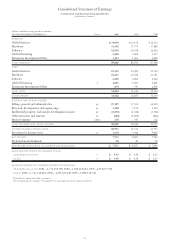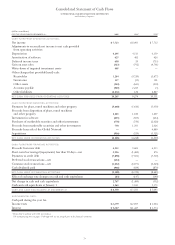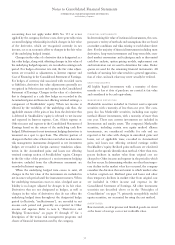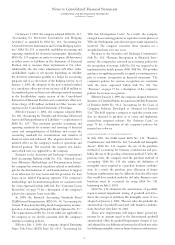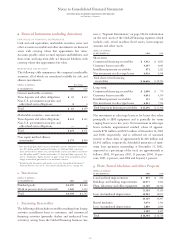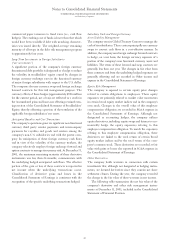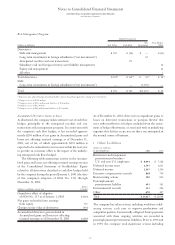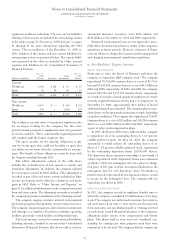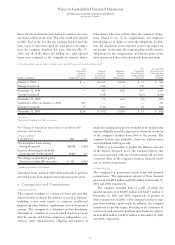IBM 2001 Annual Report Download - page 81
Download and view the complete annual report
Please find page 81 of the 2001 IBM annual report below. You can navigate through the pages in the report by either clicking on the pages listed below, or by using the keyword search tool below to find specific information within the annual report.
Notes to Consolidated Financial Statements
INTERNATIONAL BUSINESS MACHINES CORPORATION
and Subsidiary Companies
79
CUSTOMER LOANS RECEIVABLE
Global Financing is one of many sources of funding from
which customers can choose. Customer loans receivable, net
of allowances, comprise almost entirely loans made by the
company’s Global Financing segment, primarily to finance
the purchase of the company’s services and software.
Separate contractual relationships on these financing agree-
ments are generally for terms ranging from one to three
years requiring straight-line payments over the term. These
agreements do not represent extended payment terms. Each
financing contract is priced independently at competitive
market rates. An allowance for loan losses is established with
a corresponding charge to SG&A expense based upon man-
agement’s historical collection experience, prevailing economic
conditions, the present value of estimated future cash flows,
the estimated value of underlying collateral, and specific
situations that may affect a customer’s ability to repay.
ESTIMATED RESIDUAL VALUES OF LEASE ASSETS
The recorded residual values of the company’s lease assets
are estimated at the inception of the lease to be the expected
fair market value of the assets at the end of the lease term.
On a quarterly basis, the company reassesses the realizable
value of its lease residual values. In accordance with gener-
ally accepted accounting principles, anticipated increases in
specific future residual values are not recognized before real-
ization. Anticipated decreases in specific future residual
values that are considered to be other than temporary are
recognized immediately.
SOFTWARE COSTS
Costs that are related to the conceptual formulation and
design of licensed programs are expensed as research and
development. Also, for licensed programs, the company
capitalizes costs that are incurred to produce the finished
product after technological feasibility is established. The
annual amortization of the capitalized amounts is performed
using the straight-line method, and is applied over periods
ranging up to three years. The company performs periodic
reviews to ensure that unamortized program costs remain
recoverable from future revenue. Costs to support or service
licensed programs are expensed as the costs are incurred.
The company capitalizes certain costs that are incurred
to purchase or to create and implement internal-use com-
puter software, which include software coding, installation,
testing and data conversion. Capitalized costs are amortized
on a straight-line basis over two years.
COMMON STOCK
Common stock refers to the $.20 par value capital stock as
designated in the company’s Certificate of Incorporation.
Treasury stock is accounted for using the cost method.
When treasury stock is reissued, the value is computed and
recorded using a weighted-average basis.
EARNINGS PER SHARE OF COMMON STOCK
Earnings per share of common stock
—
basic is computed by
dividing Net income applicable to common stockholders by
the weighted-average number of common shares outstanding
for the period. Earnings per share of common stock
—
assuming dilution reflects the maximum potential dilution
that could occur if securities or other contracts to issue
common stock were exercised or converted into common
stock and would then share in the net income of the com-
pany. See note r, “Earnings Per Share of Common Stock,” on
page 93 for additional information.
RECLASSIFICATION S
Effective January 1, 2001, interest expense is presented in
Cost of Global Financing in the Consolidated Statement of
Earnings if the related external borrowings to support the
Global Financing business were issued by either the company
or its Global Financing units. In prior years, the Cost of
Global Financing caption only included interest related to
direct external borrowings of the Global Financing units.
Prior periods were reclassified to conform with the current
year presentation. This change was described and disclosed
in the company’s 2001 first quarter report on Form 10-Q.
The company also removed the impact of intellectual
property income, gains and losses on sales and other than tem-
porary declines in market value of certain investments,
realized gains and losses on certain real estate activity and
foreign currency transaction gains and losses from the
SG&A caption on the Consolidated Statement of Earnings.
Custom development income was also removed from the
Research, development and engineering caption on the
Consolidated Statement of Earnings. Intellectual property
and custom development income are now recorded in a
separate caption in the Consolidated Statement of Earnings.
The other items listed above are now recorded as part of
Other income and expense. Prior periods were reclassified to
conform with the current year presentation.
bAccounting Changes
STANDARDS IMPLEMENTED
The company implemented new accounting standards in
2001, 2000 and 1999. These standards did not have a material
effect on the financial position or results of operations of
the company.



